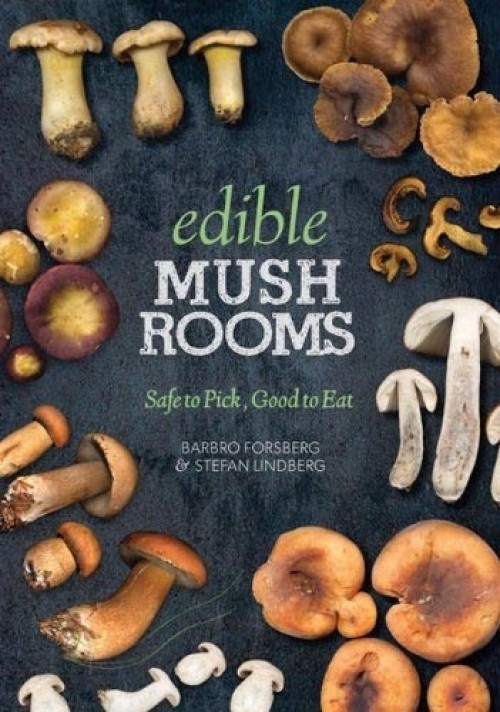by Skyhorse Publishing, New York
North American fields and forests harbor mycological treasures, but the good edibles constitute a tiny fraction of the myriad mushroom species. A good field guide is a reliable roadmap to the wild world of mushrooms, helping the forager confidently distinguish the deadly from the delicious.
The most well researched, thorough, time-tested guides are Gary Lincoff’s The National Audubon Society Field Guide to North American Mushrooms [Knopf Doubleday Publishing Group, 1981] and David Aurora’s Mushrooms Demystified [Ten Speed Press, 1986]. Lincoff’s The Complete Mushroom Hunter [Quarry Books, 2010] is more accessible and equally scientifically rigorous, with sidebars that describe the sociocultural dimensions of mushrooming and in-depth chapters on poisonous, medicinal, and psychotherapeutic mushrooms.
Adding to these standards are several recent offerings from Skyhorse Publishing designed to help mycophiles find and identify the safest and most delectable species. Edible Mushrooms, by Barbro Forsberg and Stefan Lindberg, is a standout field guide for the forager interested in learning to find and safely enjoy the culinary gems of the mushroom world. All of the major groups of charismatic, gourmet species are profiled through clear writing and vivid photography that facilitates confident mushroom identification. One gets the sense that the authors, from the mycophilic country of Sweden, have been foraging since childhood. Forsberg and Lindberg’s passion for mushroom hunting comes across in the colorful stories and sensory descriptions that introduce each species – the cauliflower mushroom “smells of pine and turpentine,” and the aroma of fresh chanterelles is “like a full-bodied aftershave.” Lindberg’s wide-angle photographs of the wet woods are so vivid you can almost smell the mycelium, providing a visceral feel for the proper habitat. Edible Mushrooms was so engaging that, after reading it, I promptly grabbed a basket and knife and headed to the nearest woodland in pursuit of morels.
Mushrooming Without Fear and Mushrooming With Confidence, both by Alexander Schwab, provide beginning and intermediate foragers with a set of ground rules for safe and rewarding mushroom hunting. The rules, including “Never, never take a mushroom with gills!” and “Never, never eat a wild mushroom raw” may be overbroad but are useful basic guidelines. These books feature checklists and photographs to ensure proper identification, as well as descriptions of notable look-alikes of the edible species. Both of Schwab’s guides have close-up photographs that distinguish gills, ridges, tubes (pores), and spines (teeth). By sticking to the species with ridges, pores, teeth, or the “mavericks” such as the giant puffball or black trumpet, beginning foragers can safely hunt for the table while avoiding the possibility of deadly look-alikes.
The Pocket Guide to Wild Mushrooms, by Pelle Holmberg and Hans Marklund, emphasizes safety and clarity while providing tips on picking, cleaning, preparing, and preserving each species. This book is conveniently sized for use in the field and has a classification system that ranks edible mushrooms by their risk of confusion with other edible, inedible, mildly poisonous, and dangerously poisonous species. This book contains plenty of useful photographs, featuring specimens of each species at different maturity levels as well as cross-sectional images. For more experienced mushroom hunters looking to branch out, this book provides detailed direction on identifying gilled mushrooms, including the Russula (brittlegill) and Lactarius (milk-cap) species – favorites in eastern European nations that are often overlooked by North American hunters.
Readers should note that these four guides from Skyhorse Publishing are written by European authors. Nearly all of the species they cover fruit in North American fields and forests, as well, but foragers from this continent should be aware of some important distinctions. The Leccinum (scaber stalk bolete) species profiled in all four of these Skyhorse field guides, though widely consumed as a staple throughout Europe, have been reported to cause gastrointestinal distress among North American foragers. Only Forsberg and Lindberg’s Edible Mushrooms explicitly notes the risks this genus – notoriously difficult to identify at the species level – may pose to mushroom hunters in North America.
There is no substitute for a foray with an expert, and books should not be used as the sole basis for identifying a gourmet mushroom. Still, a good field guide is indispensable. Throw one of these books in your basket, put on your forager’s eyes, and head to the nearest forest today – tasty treasures await the patient and prudent hunter.


